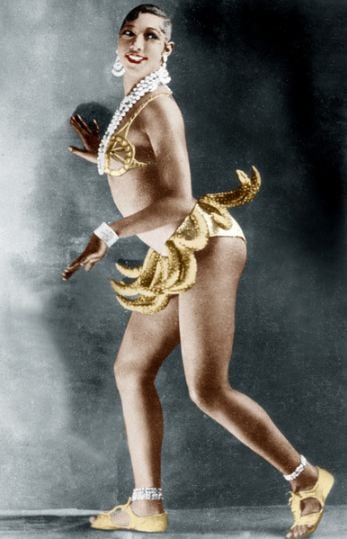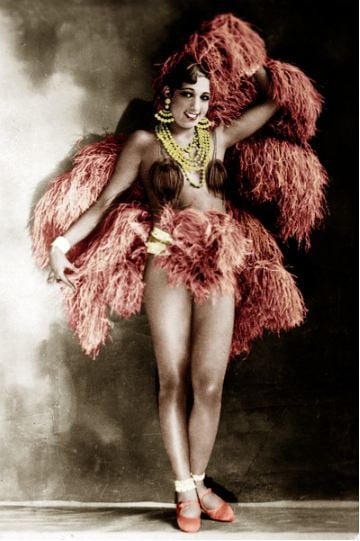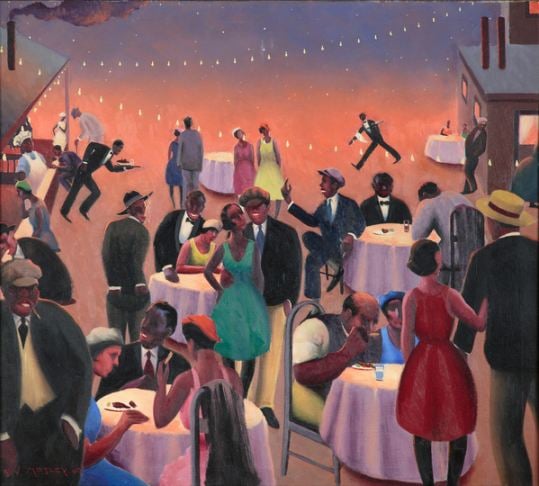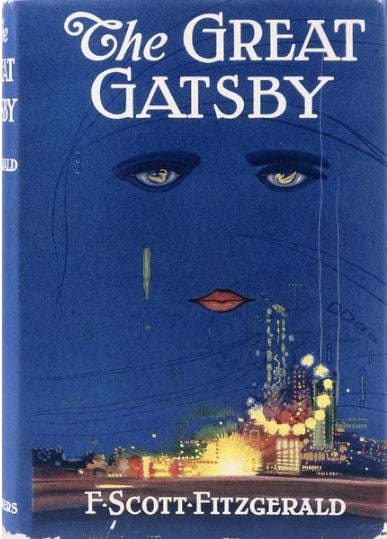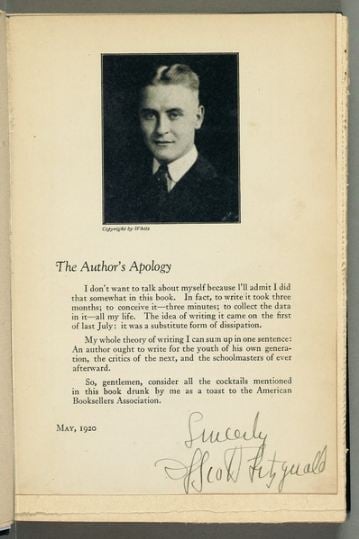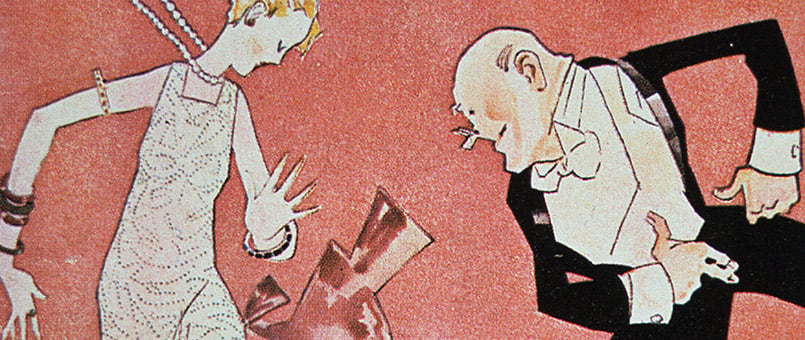
Upbeat and High Tempo: The Jazz Age
The Jazz Age was a post-WWI movement in the 1920s from which jazz music, dance and a new joie de vivre emerged. Often referred to in conjunction with the Roaring Twenties, this golden decade opened doors for equality, sexuality and liberation until it ended with the onset of the Great Depression in 1929.
Dancing pair with woman in orange from Le Tumulte Noir (detail), pub. 1929 (pochoir print), Paul Colin (1892-1985) / Private Collection / The Stapleton Collection / Bridgeman Images
Celebrate the era by exploring cultural highlights and stars of the Jazz Age, from the raunchy performers to the literary giants:
Music
Jazz originated in New Orleans as a fusion of African and European music; New Orleans enabled this occurrence because it was a port city with several different cultures intertwined. As its popularity spread, cities like New York and Chicago also became cultural centres for jazz and the spirited music grew to play a major part in wider cultural changes of the period, particularly concerning issues of race.
Jazz drew its influences from creole, ragtime and most importantly blues music. It flourished in illicit speakeasies and was considered somewhat immoral as it threatened old cultural values; some urban middle-class African Americans perceived it as the ‘devil’s music’ and believed that the improvised rhythms and sounds were promoting promiscuity.
Louis Armstrong playing the trumpet, various shots, c.1924 / Bridgeman Footage
In addition to legendary trumpeter Louis Armstrong (featured above), who helped to pioneer jazz’s improvisational style, other notable musicians of this vibrant decade include Kid Ory, King Oliver, Bessie Smith, Jelly Roll Morton and Fletcher Henderson.
Dance
Naturally, with such upbeat songs and new style of music, the dancing had to follow suit! All of the pre-war dances became unfashionable and were snubbed in favour of the Charleston, the Lindy Hop and the Fox-Trot (previously known as the One-Step).
Jazz music also spawned a generation of young Western women known as flappers, who sported bob haircuts and short or embroidered dresses, while exhibiting a passion for dancing and flouting conventional social and sexual behaviour.
Dancing in the 20s, Charleston, Isadora Duncan, dance class and competitions, Jazz band / Bridgeman Footage
One American-born French jazz singer, dancer and actress in particular took Europe by storm when she sashayed onto a Paris stage with a comic yet sensual appeal and some outrageous barely-there dresses. Josephine Baker symbolised the beauty and vitality of Black American culture and her wild popularity helped to combat racial issues across Europe and parts of America.
See more: Dance showreelThe world famous entertainer and all-round remarkable woman was also the first black woman to star in a major motion picture: Zouzou in 1934. The femme fatale was even made a Chevalier of the Légion d’honneur by General Charles de Gaulle for her work in the French Resistance.
Art
With its fresh outlook and fervent spirit, it’s no surprise that the Jazz Age was quite a popular subject matter for art of the era. The stylish garments prompted plenty of beautiful fashion illustrations, while the music inspired artists such as Piet Mondrian to create his unique grid-and-block aesthetic based on the improvisational nature of jazz beats.
Barbecue, circa 1934 (oil on canvas), Archibald J. Motley Jr.(1891-1981) / Howard University Gallery of Art, Washington DC, USA / © Valerie Gerrard Browne / Chicago History Museum / Bridgeman Images
One of the greatest visual chroniclers of 20th century American life, particularly that of the African-American experience in the 1920s and 30s, was Archibald John Motley (1891 – 1981). After he graduated from studying painting at the School of the Art Institute of Chicago in 1918, he became one of the major contributors to the Harlem Renaissance, a time in which African-American art reached new heights across America. His colourful artworks often depict lively scenes that were typical of the Jazz Age, ranging from sophisticated gatherings to people dancing along to the sound of trumpets.
Literature
The Jazz Age is distinct from other literary movements of its era in that it was more of a cultural movement. Art forms reacted to changing times by changing their rules; many writers started to deviate from the literary forms and norms that had defined the last generation.
The top authors of the period include Ernest Hemingway, William Faulkner, Gertrude Stein, Michael Arlen, F. Scott Fitzgerald and his wife Zelda Sayre Fitzgerald. The 24th September 2016 marked the 120th anniversary of the birth of F. Scott Fitzgerald, who is widely regarded as one of the greatest American writers of the 20th century.
Front cover for the first edition of ‘The Great Gatsby’ by F. Scott Fitzgerald, 1925 (colour pictorial dust jacket), Francis Cugat / Private Collection / Photo © Christie’s Images / Bridgeman Images
Signed copy of ‘This Side of Paradise’, 1920 (print & pen and ink on paper), F. Scott Fitzgerald (1896-1940) / Private Collection / Photo © Christie’s Images / Bridgeman Images
Fitzgerald’s most famed novel, The Great Gatsby, provides a critical social history of America during the Roaring Twenties within its narrative. The evolution of jazz music, flapper culture, criminal activity and unprecedented economic prosperity are skilfully depicted in the beautiful tale, which educates readers about the era’s garish society by placing a timeless and relatable plotline within a historical context.
“I was within and without. Simultaneously enchanted and repelled by the inexhaustible variety of life.” – The Great Gatsby
Incredibly The Great Gatsby did not become popular until after Fitzgerald’s death; as such the writer often encountered financial difficulties and struggled to maintain his New York celebrity lifestyle. In addition to other masterpieces such as The Beautiful and the Damned, he also wrote numerous short stories, many of which treat themes of youth and promise, and age and despair.
And so to summarise, in the words of Hugh Hefner:
“I look back on the Roaring Twenties, with its jazz, Great Gatsby and the pre-Code films as a party I had somehow managed to miss.”


